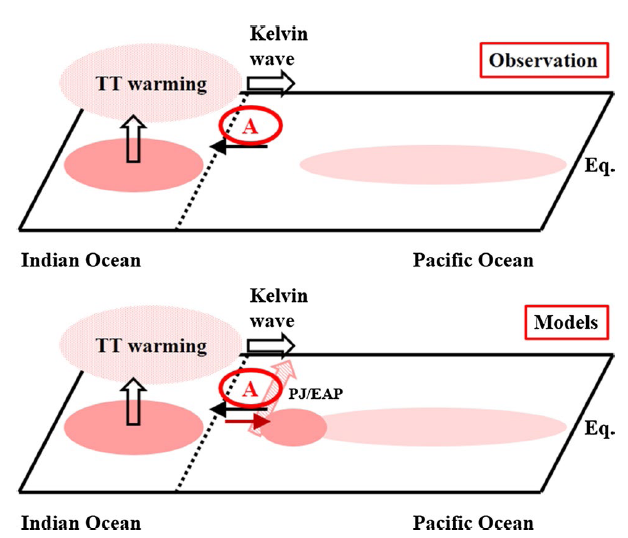IAP reveals the biases in simulation of the Indian Ocean basin mode and its capacitor effect in CMIP3/CMIP5 models
Date:2015-05-12
The Indian Ocean Basin Mode (IOBM) is the first leading mode of the interannual Indian Ocean SST, which has an important impact on the East Asian climate, including summer rainfall, typhoon, and high temperature extremes. During the El Ni?o decaying summer, the IOBM warming can trigger a Matsuno-Gill response, which contributes to the maintenance of the anomalous northwest Pacific anticyclone (NWPAC) via the “capacitor effect”. Therefore, the simulation of the IOBM and its capacitor effect in CMIP models is very important for the East Asian summer climate, and understanding the biases of them is conducive to improve the models’ performance.
TAO Weichen, HUANG Gang et al. from the Institute of Atmospheric Physics investigated the biases in simulation of IOBM and its capacitor effect in 15 CMIP3 and 32 CMIP5 models. They found that most CMIP models simulate a stronger Cloud-radiation-SST feedback and a weaker wind-evaporation- SST feedback.

Schematic diagram illustrating the mechanism of summer NWPAC in observation (top) and models (bottom).
During the El Ni?o developing fall and the following spring, most CMIP models simulate reasonable short wave radiation (SWR) and weaker latent heat flux (LHF) anomalies, which leads to a weak bias of atmospheric processes. During winter, most models simulate stronger SWR and reasonable LHF anomalies, leading to a strong bias of atmospheric processes. The thermocline feedback is stronger in most models. Moreover, the effect of oceanic processes offset the weak bias of atmospheric processes in spring, and the IOBM warming can persist into summer.
The anomalous NWPAC is weaker due to weak and west bias of the capacitor effect. The unrealistic western Pacific SST anomalies in models trigger the westward extension of Rossby wave from the Pacific, weakening the effect of Kelvin wave from the Indian Ocean. Compared to CMIP3, CMIP5 models simulate the feedbacks more realistically and display less diversity.
Citation: Tao,W., G. Huang*,K. Hu, H. Gong, G. Wen and L. Liu, 2015: A study of biases in simulation of the Indian Ocean basin mode and its capacitor effect in CMIP3/ CMIP5 models, Climate Dynamics,2015,DOI: 10.1007/s00382-015-2579-0
Download: http://link.springer.com/article/10.1007%2Fs00382-015-2579-0
Contact: HUANG Gang, hg@mail.iap.ac.cn
